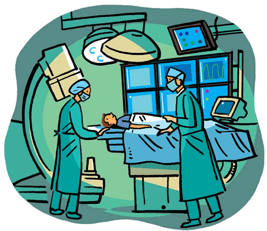 The most important role of a parent or guardian is to keep your child calm. The best way to keep your child calm is to be calm yourself. Knowing what to expect and explaining it to your child beforehand is the best way for both you and your child to be prepared for this procedure. Here are some guidelines to use when discussing the heart cath with your child.
The most important role of a parent or guardian is to keep your child calm. The best way to keep your child calm is to be calm yourself. Knowing what to expect and explaining it to your child beforehand is the best way for both you and your child to be prepared for this procedure. Here are some guidelines to use when discussing the heart cath with your child.
At any age
Your child may bring along a “comfort” item — such as a favorite stuffed animal or “blankie” — to hold during the procedure. There are televisions in the Same Day Surgery rooms, but you are welcome to bring along a portable DVD player, laptop computer, or hand-held video game, if these items will help your child.
Birth to 2 years
Please bring along a “comfort” item for your child, such as a favorite blanket, stuffed animal, or toy.
2 to 7 years
The day before your child’s heart cath, explain the procedure using simple words. You might explain that the doctor “will take pictures of your heart while you are taking a nap.”
A medical play kit can be helpful so that your child is familiar with items he or she may see. For example, you can show your child how to use a stethoscope on a teddy bear. Books about going the hospital also might be helpful.
7 to 11 years
Older children may benefit from discussing the heart cath about a week or so before the scheduled date. At this point, kids understand more about the body, the organs, and how they work.
For that reason, they may be more afraid of pain. You might explain to your child that he or she will be getting medication that will make him or her very sleepy throughout the heart cath, and that this medication will keep him or her from feeling any discomfort during the procedure. It also will make it hard to remember much about the procedure afterward.
You might add that the heart is like a pump, and the heart cath will help the doctor understand how well your child’s heart is pumping. Books about going to the hospital also might be helpful.
12 years and up
Preteens and teens are able to understand the way the heart works, what their heart problem is, and why they need this procedure. They might ask very insightful questions. Use their questions to help guide your discussion.









 At UPMC Children’s Hospital of Pittsburgh, we believe parents and guardians can contribute to the success of this procedure, and we invite you to participate. Please read the following information to learn about the procedure and how you can help.
At UPMC Children’s Hospital of Pittsburgh, we believe parents and guardians can contribute to the success of this procedure, and we invite you to participate. Please read the following information to learn about the procedure and how you can help. The most important role of a parent or guardian is to keep your child calm. The best way to keep your child calm is to be calm yourself. Knowing what to expect and explaining it to your child beforehand is the best way for both you and your child to be prepared for this procedure. Here are some guidelines to use when discussing the heart cath with your child.
The most important role of a parent or guardian is to keep your child calm. The best way to keep your child calm is to be calm yourself. Knowing what to expect and explaining it to your child beforehand is the best way for both you and your child to be prepared for this procedure. Here are some guidelines to use when discussing the heart cath with your child.